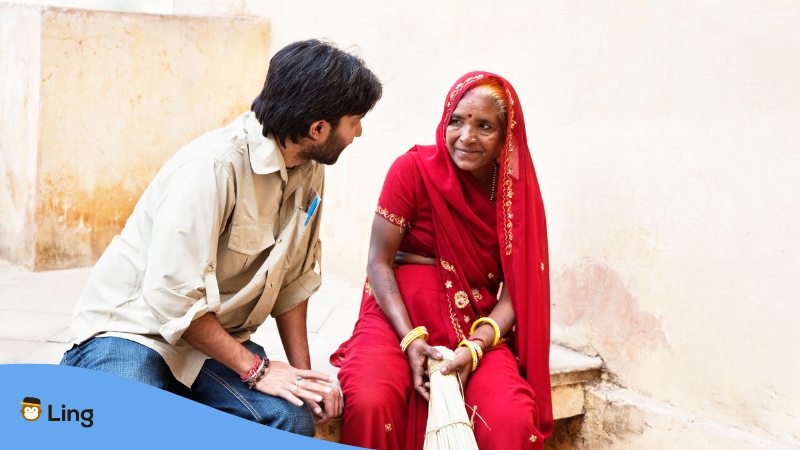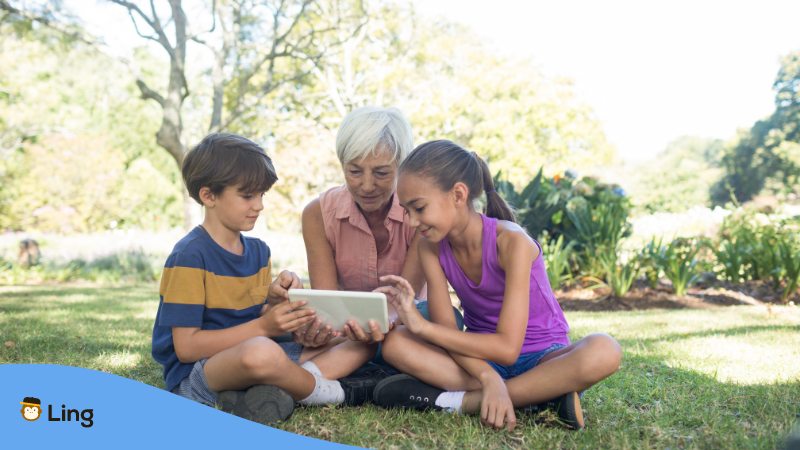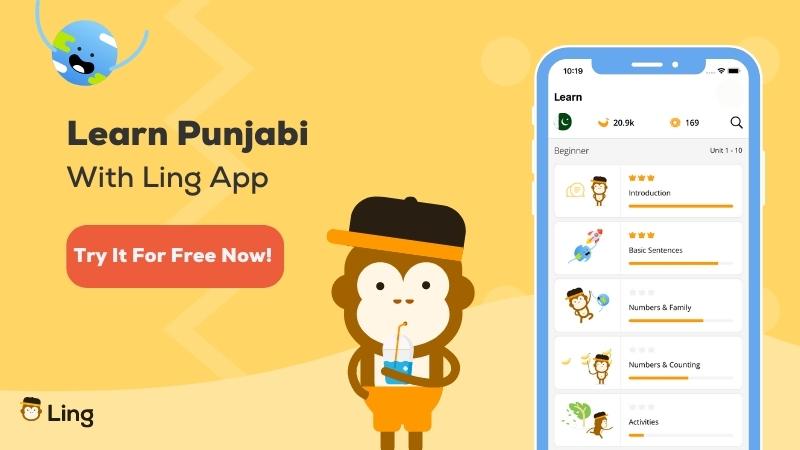ਸਤ ਸ੍ਰੀ ਅਕਾਲ (Sat Sri Akal, Hello), fellow language adventurers! Are you excited to embark on a linguistic trip through the vibrant world of Punjabi?
Today, we’re going to talk about the key to any successful conversation — politeness. In this one-of-a-kind article, we will focus on polite Punjabi phrases that will surely help you make a great impression wherever you go.
With the Punjabi language being spoken across India and Pakistan, learning these polite phrases will surely help you build meaningful connections with locals. Let’s get started!
Essential Polite Punjabi Phrases
Alright, let’s kick things off by getting familiar with some polite Punjabi phrases that are indispensable in everyday conversations.
Trust me, knowing these will make your journey through the Punjabi-speaking regions a lot more enjoyable and engaging.
Greetings And Salutations
Let’s start with the basics – the two main types of greetings in Punjabi culture: common verbal greetings and traditional gestures. You’ll want to know these to fit right in!
Common Greetings And Their Meanings
In this little section, we’ll go over some cool verbal greetings that’ll help you show respect and friendliness.
Meeting new people or catching up with old pals? No problem! I’ll help you know exactly what to say.
- ਸਤ ਸ੍ਰੀ ਅਕਾਲ (Sat Sri Akal): A respectful way to say “hello,” which means “God is the eternal truth.”
- ਨਮਸਤੇ (Namaste): A versatile greeting often used in India, suitable for any time of the day.
- ਸਸ਼੍ਰੀ ਕਾਲ (Sasri Kaal): A casual and friendly “hello” used among friends and family.
- ਗੁੱਡ ਮੌਰਨਿੰਗ (Guda mauraniga): A common way to say “good morning” in Punjabi, a borrowed English word.
Traditional Punjabi Greeting Gestures
Next up, the physical gestures that often go hand-in-hand with verbal greetings in any Punjab region.
Master these to convey warmth and respect and add a personal touch to your interactions. You’ll be greeting people like a Punjabi soon!
- Joining hands: Place your palms together near your chest, bow your head slightly, and say your chosen greeting.
- Nodding: A simple nod of acknowledgment can go a long way when you’re unsure of the appropriate gesture.
- Warm smiles: A genuine smile can make your greetings more welcoming and convey a sense of friendliness.
- Light touch: A gentle touch on the shoulder or elbow can add warmth to your greetings, especially among close friends and family.

Polite Expressions And Vocabulary
Now, let’s go into some must-know polite expressions and vocabulary in Punjabi. These common phrases will help you sail through various social situations like a charm!
Essential Polite Phrases For Everyday Communication
Here’s the deal – I will teach you some polite Punjabi phrases to show politeness in daily convos.
After this, you’ll be making requests, agreeing or disagreeing, and chatting away more effectively with Punjabi speakers.
- ਕਿਰਪਾ ਕਰਕੇ (Kripa karke): A polite way to say “please.”
- ਹਾਂ ਜੀ (Haan ji) / ਨਹੀਂ ਜੀ (Nahi ji): Say “yes, please” or “no, thank you” by adding “ji” for extra politeness.
- ਬਹੁਤ ਮਿਹਰਬਾਨੀ (Bahut meherbaani): A formal way to say “thank you very much.”
- ਹੋਰ ਕੁਝ (Hor kujh): A polite way to say “anything else” when offering help or assistance.
Expressing Gratitude And Appreciation Politely
Who doesn’t love a heartfelt “thank you”? Let me share with you some awesome ways to express gratitude and appreciation in Punjabi in a polite way.
Make people feel valued and leave a lasting impression. They’ll love you for it!
- ਧੰਨਵਾਦ (Dhanwaad): A heartfelt “thank you.”
- ਬਹੁਤ ਬਹੁਤ ਧੰਨਵਾਦ (Bahut bahut dhanwaad): Emphasize your thanks with “very, very much.”
- ਸ਼ੁਕਰੀਆ (Shukria): An alternative way to say “thank you,” borrowed from Urdu.
- ਤੁਹਾਡੀ ਮਿਹਰਬਾਨੀ (Tuhadi meherbaani): A polite way to say “thank you for your kindness.”
Apologizing And Seeking Forgiveness In A Polite Way
Oops! We all mess up sometimes, but it’s how we fix things that really matter.
In this part, we’ll cover the art of apologizing and seeking forgiveness in Punjabi in a polite manner. Show humility and respect, and you’ll be forgiven in a jiffy.
- ਮਾਫ਼ ਕਰਨਾ (Maaf karna): Say “I’m sorry” or “excuse me” with this versatile phrase.
- ਮੇਰੀਮੇਰੀ ਗਲਤੀ (Meri galti): Admit your mistake by saying “my fault” to show sincerity.
- ਕੋਈ ਹਰਜ ਨਹੀਂ (Koi harj nahi): A colloquial but polite way to say “no problem” or “no harm done” when forgiving someone.
- ਮੇਰੀ ਖਿਮਾ ਮੰਗਦਾ (Meri khima mangda): A humble way to ask for forgiveness, meaning “I seek your pardon.”
Asking For Help Or Information Politely
No more awkward moments when asking for help or info! Let me teach you how to ask for assistance or information politely and respectfully.
With these basic phrases up your sleeve, you’ll be confidently seeking help like a pro.
- ਮੇਰੀ ਮਦਦ ਕਰੋ ਜੀ (Meri madad karo ji): A humble way to ask for help by adding “ji” to show respect.
- ਤੁਸੀਂ ਕੋਈ ਸੁਝਾਅ ਦੇ ਸਕਦੇ ਹੋ? (Tusi koi sujhaav de sakde ho?): Politely inquire, “Can you give any suggestions?”
- ਇਹ ਕਿਵੇਂ ਕਰਦਾ ਹੈ? (Ih kiven karda hai?): A polite way to ask “How does this work?” when seeking information about something.
- ਤੁਸੀਂ ਮੇਰੇ ਨਾਲ ਬੋਲ ਸਕਦੇ ਹੋ? (Tusi mere naal bol sakde ho?): A friendly way to ask “Can you talk with me?” when seeking conversation or assistance.

Addressing People Respectfully With Polite Punjabi Phrases
Now that we’ve covered the basics, let’s level up your Punjabi politeness game. Here, we’ll explore how to address people respectfully using polite Punjabi phrases.
Remember, it’s all about making a great impression and connecting with others!
Using Honorific Titles And Appropriate Pronouns
In Punjabi culture, using honorific titles and appropriate pronouns is a must. It shows respect and consideration. Let’s see some examples to get you started:
- ਜੀ (ji): Add “ji” after a person’s name, title, or pronoun to show respect. For example, ਰਾਜੇਸ਼ ਜੀ (Rajesh ji) or ਸਾਹਬ ਜੀ (Sahib ji).
- ਤੁਹਾਡਾ (Tuhada) / ਤੇਰਾ (Tera): Use “Tuhada” as a polite way to say “your,” while “Tera” is a more informal version.
- ਆਪਣਾ (Aapna): This term means “our” or “ours” and is used when speaking to someone you want to show respect to.
Importance Of Addressing Elders And People In Higher Positions Respectfully
Punjabi culture places great importance on respecting elders and those in higher positions. Here are some examples to help you show proper respect:
- Always use “ਆਪ ਜੀ (Aap ji)” when addressing elders or people in higher positions, instead of the more informal “ਤੁਸੀਂ (Tusi).”
- When speaking to teachers or professors, use “ਸਰ (Sir)” for males and “ਮੈਡਮ (Madam)” for females.
- For doctors or other professionals, use their professional title, such as “ਡਾਕਟਰ (Doctor)” followed by their name.
Tips For Addressing People With Unknown Names Or Titles
Sometimes, you might need a little effort to address someone whose name or title you don’t know. No worries! Here are some tips for handling these situations like a pro:
- Use “ਸਰਦਾਰ ਜੀ (Sardar ji)” for Sikh men and “ਬੀਬੀ ਜੀ (Bibi ji)” for Sikh women. These terms are respectful and widely accepted.
- If you’re unsure about someone’s religion, opt for the more neutral “ਭਾਈ ਸਾਹਬ (Bhai Sahib)” for men and “ਬਹਨ ਜੀ (Behan ji)” for women.
- In a professional setting, “ਸਾਹਬ ਜੀ (Sahib ji)” is a safe bet for men, while “ਮੈਡਮ ਜੀ (Madam ji)” works well for women.

Polite Conversational Etiquette In Punjabi Culture
Ready to level up your Punjabi politeness even more? Great! In this part, we’ll focus on conversational etiquette that’ll help you shine when you speak Punjabi.
Get ready to make friends and influence people with your superb communication skills!
Active Listening And Patience
Active listening and patience are crucial in Punjabi culture. It shows that you’re genuinely interested in what the other person says. Here’s how to do it right:
- Nodding and making affirmative sounds like “ਹਾਂ ਜੀ (Haan ji)” and “ਬਹੁਤ ਵਧੀਆ (Bahut vadiya)” to show you’re engaged.
- Avoiding distractions, such as looking at your phone or fidgeting.
- Asking open-ended questions to encourage the native speaker to share more.
Avoiding Interruptions
Interrupting someone is considered impolite in Punjabi culture. To make sure you’re respectful, follow these tips:
- Wait for a natural pause in the conversation before speaking.
- If you must interrupt, say “ਮਾਫ਼ ਕਰਨਾ (Maaf karna)” or “ਕਿਰਪਾ ਕਰਕੇ (Kripa karke)” to apologize for the interruption.
- Avoid speaking over the other person, and give them ample time to finish their thoughts.
Indirect Communication And Understanding Non-Verbal Cues
In Punjabi culture, people often communicate indirectly through non-verbal cues. To navigate these interactions, consider the following:
- Pay attention to body languages, such as eye contact, hand gestures, and facial expressions.
- Listen for subtle cues, like changes in tone or hesitation that may indicate a hidden message or discomfort.
- Be sensitive to cultural differences in communication styles, and adapt your approach accordingly.
Modesty And Humility In Conversations
Punjabi culture values modesty and humility, so it’s essential to keep these qualities in mind during conversations. Here’s how to be modest and humble:
- Refrain from boasting about your accomplishments or possessions.
- Accept compliments graciously with a simple “ਧੰਨਵਾਦ (Dhanwaad)” or “ਬਹੁਤ ਸ਼ੁਕਰੀਆ (Bahut shukriya).”
- Show empathy and understanding, especially when discussing sensitive topics or offering advice.
Additional Polite Phrases In The Punjabi Language
Looking for even more polite Punjabi phrases to add to your language toolkit? I got you!
Here are some extra expressions that will come in handy during various social interactions.
| English | Punjabi | Pronunciation |
| Can you repeat that, please? | ਕੀ ਤੁਸੀਂ ਇਹ ਦੁਬਾਰਾ ਕਹਿ ਸਕਦੇ ਹੋ? (Kī tusīṁ ih dubārā kahi sakde ho?) | Ki tu-si eh du-ba-ra keh sak-de ho? |
| Enjoy your meal | ਆਪਣਾ ਖਾਣਾ ਆਨੰਦ ਲਉ (Āpṇā khāṇā ānand lau) | Aap-na kha-na aanand lau |
| Excuse me for a moment | ਇਕ ਮਿੰਟ ਲਈ ਮੁਆਫ਼ ਕਰੋ (Ik miṇṭ laī muāf karo) | Ik mint lai mu-aaf ka-ro |
| Good night | ਸ਼ੁਭ ਰਾਤ੍ਰੀ (Shubh rātrī) | Shu-bh raat-ri |
| Have a safe journey | ਸੁਰੱਖਿਅਤ ਯਾਤਰਾ ਰਹੇ (Surakhiyat yātrā rahē) | Su-rak-hi-yat ya-tra rahe |
| How are you? | ਤੁਹਾਨੂੰ ਕਿਵੇਂ ਲੱਗ ਰਿਹਾ ਹੈ? (Tuhānū kivēṁ lag rihā hai?) | Tu-ha-no kiv-en lag ri-ha hai? |
| It’s nice to meet you | ਤੁਹਾਨੂੰ ਮਿਲਕੇ ਖੁਸ਼ੀ ਹੋਈ (Tuhānū milke khuśī hōī) | Tu-ha-no mil-ke khush-ee ho-ee |
| Please speak slowly | ਕਿਰਪਾ ਕਰਕੇ ਹੌਲੀ ਹੌਲੀ ਬੋਲੋ (Kripā karke haulī haulī bolo) | Kri-pa kar-ke hau-li hau-li bo-lo |
| Please take a seat | ਕਿਰਪਾ ਕਰਕੇ ਬੈਠੋ (Kripā karke baiṭho) | Kri-pa kar-ke bai-tho |
With these extra phrases at your disposal, you don’t need to find English-speaking locals to help you out.
You’re now well-equipped to navigate the beautiful world of Punjabi culture with confidence and grace.
Keep practicing because every little effort you put into learning the Punjabi language will go a long way in helping you connect with the people you meet.
Learn The Polite Phrases In Punjabi With Ling!
And there you have it, friends! We’ve shared a bunch of polite Punjabi phrases and conversational etiquette tips to help you bond with Punjabi speakers like a pro.
Now it’s your turn to practice these expressions and discover the warm, welcoming world of Punjabi culture.
Remember, learning a new local language is all about enjoying the journey and making meaningful connections. So keep practicing, stay curious, and most importantly, have fun!
And speaking of fun, have you heard about the Ling app? It’s this cool, game-like app that makes language learning a blast!
With over 60 languages, including Thai, Malay, Cantonese, and Punjabi, you’ll never run out of languages to explore. It’s available on iOS and Android, so go on and download it now!
Try the Ling app and see how it spices up your language-learning journey. It’s a real game-changer!





















